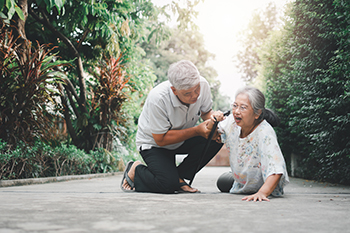Items filtered by date: February 2024
Causes of Falls in Older Adults

Falls among older adults are a common concern, with more than one in four individuals aged 65 or older experiencing a fall each year. Numerous factors contribute to falls in older adults, including age-related changes, such as diminished vision, hearing, reflexes, and muscle mass, all of which can impact balance. Additionally, medical conditions such as diabetes, heart disease, neuropathy, and thyroid disorders often compromise stability. Other factors include mobility issues such as gait abnormalities, muscle weakness, and abrupt changes in blood pressure. Medications can increase the risk of falls by inducing side effects like dizziness or confusion. Foot problems, including painful conditions and wearing unsuitable footwear, such as high heels or backless shoes, further add to the likelihood of falling. Environmental factors, consisting of slippery floors or inadequate lighting at home or in the community, also pose significant hazards. Prevention tips include seeking appropriate medical care, wearing supportive footwear, and creating a safe living environment. If concerns about foot health or falls prevention arise, it is suggested that you seek guidance from a podiatrist who is medically trained to manage these concerns.
Preventing falls among the elderly is very important. If you are older and have fallen or fear that you are prone to falling, consult with Wendy K. Stinson, DPM from New Jersey. Our doctor will assess your condition and provide you with quality advice and care.
Every 11 seconds, an elderly American is being treated in an emergency room for a fall related injury. Falls are the leading cause of head and hip injuries for those 65 and older. Due to decreases in strength, balance, senses, and lack of awareness, elderly persons are very susceptible to falling. Thankfully, there are a number of things older persons can do to prevent falls.
How to Prevent Falls
Some effective methods that older persons can do to prevent falls include:
- Enrolling in strength and balance exercise program to increase balance and strength
- Periodically having your sight and hearing checked
- Discuss any medications you have with a doctor to see if it increases the risk of falling
- Clearing the house of falling hazards and installing devices like grab bars and railings
- Utilizing a walker or cane
- Wearing shoes that provide good support and cushioning
- Talking to family members about falling and increasing awareness
Falling can be a traumatic and embarrassing experience for elderly persons; this can make them less willing to leave the house, and less willing to talk to someone about their fears of falling. Doing such things, however, will increase the likelihood of tripping or losing one’s balance. Knowing the causes of falling and how to prevent them is the best way to mitigate the risk of serious injury.
If you have any questions, please feel free to contact our office located in Parsippany-Troy Hills, NJ . We offer the newest diagnostic and treatment technologies for all your foot care needs.
